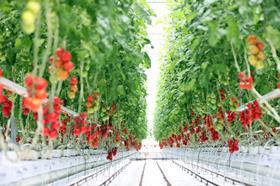
Construction is set to begin on two of Britain’s largest and lowest-carbon greenhouses, featuring the world’s first heating system to use waste heat from water treatment facilities.
The £120 million greenhouse venture is being financed by Greencoat Capital, the UK’s largest green energy investor, backed by major UK pension funds, and will be capable of growing 12 per cent of the UK’s tomatoes.
The greenhouses will be among the largest built in the UK with each covering more than 13 hectares, larger than the Millennium Dome. Construction will be carried out by UK company Oasthouse Ventures.
One greenhouse will be situated outside Bury St Edmunds, Suffolk, with another on farmland near Norwich. Together they will cover 29 hectares, the equivalent of 47 football pitches.
Once operational, they will create 360 jobs in the local area, rising to 480 during peak season. Commercial scale growers from UK and Netherlands have already committed to leasing the space, according to Greencoat Capital.
James Samworth, partner at Greencoat Capital, said: “We’re very pleased to have achieved another innovative first in the UK renewable energy sector. Technology and cross-sector co-operation is continuing to unlock some amazing possibilities in energy and agriculture.
“We see considerable opportunity to invest in renewable heat in the UK, providing pensions investors with the predictable returns they require to pay beneficiaries, meanwhile reducing our carbon emissions as an economy.”
Standing around 7 metres tall, the large glass structures allow crops to grow vertically along guidewires, and do not require any soil, instead being grown hydroponically from nutrient rich water solutions.
Once in full production, they will be capable of growing more than 20 tonnes of tomatoes every day.
The greenhouses will use ground-breaking technology to reduce the carbon footprint of greenhouse production by 75 per cent compared to their European counterparts.
The greenhouses will be warmed by heat pumps using waste heat from water recycling centres, which displaces the conventional gas heating of commercial greenhouses.
Anglian Water will provide the project’s source heat via two sites at Norwich and Bury St Edmunds, with the added benefit of removing excess heat from river systems.
Dr Lu Gilfoyle, head of environmental quality at Anglian Water said: “It has been great to be involved in such an innovative project, helping to solve a number of challenges for Anglian.
“Removing excess heat from the river systems is a priority for Defra and ourselves, and it is fantastic to be able to put that heat energy to good use.”
Electricity for the greenhouses’ heat pumps will be provided by a Combined Heat and Power system (CHP), with waste from the CHP providing further warmth for the greenhouses.
Andy Allen, director at Oasthouse Ventures, added: “Delivering a world first low carbon greenhouse system is hugely exciting for the small team who took this from conception, design and planning, to contracting and now construction.
“The environmental, social and political benefits of these systems are significant, and we look forward to further disrupting the traditional carbon heavy models of agriculture.”
Capital for the project comes from a number of public and private pensions in the UK, part of a wider trend of funds investing in indoor agriculture projects.



